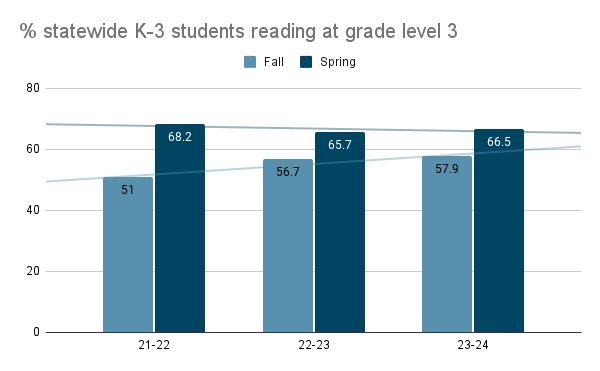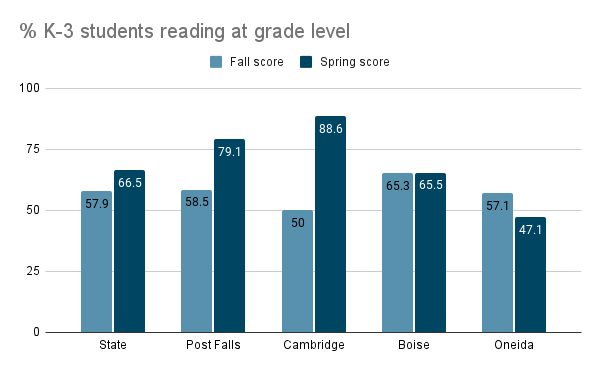Most Idaho K-3 students became stronger readers from the beginning to the end of last school year, according to recently released results from the state’s twice-annual reading exam.
Statewide, K-3 student literacy improved from about 58% of students reading at grade level last fall to more than 66% this spring.
Typically, students show reading growth from fall to spring, then a slight decline over the summer, followed by another spurt — a two-steps-forward, one-step-backward type of progress. Over time, there should be a trend of steady reading progress.
While Idaho’s K-3 students have been consistently improving their reading skills from fall to spring, that growth has narrowed over the past three school years, and overall progress on the spring reading exam has slightly declined.

Proficiency levels have not caught up to pre-pandemic scores; nearly 70% of students were reading at grade level in spring 2019. The pandemic and changes to the Idaho Reading Indicator exam (IRI) have been cited as contributors to lower-than-anticipated scores.
When spring reading scores are broken down at the district and charter level, nearly all showed some growth, though there were wide disparities in terms of how much.

At the rural Cambridge School District, for example, student reading proficiency increased by 38.6 percentage points. Post Falls was a standout among large districts, with a 20 percentage point increase. Boise stood out among large districts for another reason — its minimal growth. There was an increase of just 0.2 percentage points from fall to spring.
In a few cases, literacy rates declined over the course of the school year.
Oneida County School District showed the worst regression in the state, with a 10 percentage point decline in student reading proficiency. About 8,000 students attend Oneida, and about 7,000 of them attend the district’s online school and live in various parts of the state.
The release of spring reading scores comes as Idaho Department of Education officials are considering overhauling the IRI. They expect to announce whether the exam will be changing in mid-August, when a potentially new vendor will be awarded the exam contract. The state’s current vendor is iStation.
For a look at where student reading progress is the best — and worst — take a look at the lists below.
Search for your local district or charter’s growth here.
Greatest growth by charters / nontraditional schools
A diverse bunch of charters claimed the state’s greatest reading growth. They include schools from east and central Idaho, and from the Treasure Valley. They also include a few online schools, some that were rural, and others in urban centers. Most are relatively small.
| Charter (location) | Fall to spring growth, in percentage points | # Test takers |
| Syringa Mountain Charter (Hailey) | +21.8 | 57* |
| Taylor’s Crossing Public Charter (Idaho Falls) | >20 | 120* |
| Monticello Montessori Charter (Ammon) | 19.3 | 92 |
| Gem Prep: Meridian | 18.4 | 174 |
| White Pine Charter (Ammon) | 18.1 | 286 |
| Blackfoot Charter Community Learning Center | 17.7 | 189 |
| Forge International (Sage International, Middleton) | 15.8 | 161 |
| Gem Prep: Nampa | 14.8 | 201 |
| Gem Prep: Online | 14.7 | 83* |
| Idaho Virtual High | 14.2 | 94 |
*# of test takers estimated according to K-3 enrollment
Greatest growth by traditional school districts
Most districts on this list are relatively small and rural, and represent geographically diverse parts of the state.
| District | Fall to spring growth, in percentage points | # Test takers |
| Cambridge | 38.6 | 43* |
| Bliss | 30.7 | 50 |
| Highland | 28.2 | 48 |
| Culdesac | 26.8 | 48 |
| Nezperce | 26 | 51 |
| Soda Springs | 24.7 | 244 |
| Garden Valley | 22.9 | 50* |
| Valley | 22.6 | 137 |
| Boundary County | 22.6 | 332 |
| Firth | 21.7 | 204 |
*# of test takers estimated according to K-3 enrollment
Greatest growth by large traditional school districts
Two North Idaho districts showed the greatest reading growth among peers of their size (out of 25 districts with the highest enrollment). And North Idaho districts claimed five of the top 10 spots.
| District | Fall to spring growth, in percentage points | # Test takers |
| Post Falls | 20.6 | 1833 |
| Lakeland | 17.2 | 1232 |
| Caldwell | 13.9 | 1677 |
| Lake Pend Oreille | 13.9 | 1033 |
| Jefferson County | 12.6 | 1861 |
| Kuna | 12.6 | 1641 |
| Bonneville | 12.5 | 3790 |
| Lewiston | 12.3 | 1277 |
| Coeur d’Alene | 12.2 | 2704 |
| Nampa | 11.8 | 3907 |
Most regression / least growth by charters / nontraditional schools
A half dozen Treasure Valley charters are among those with regression or minimal growth.
| Charter (location) | Fall to spring regression, in percentage points | # Test takers |
| Pinecrest Academy of Lewiston | -23.3 | 74 |
| McCall Community School | -19.3 | 44 |
| Upper Carmen Public Charter | -14.3 | 56 |
| Idaho Virtual Academy | -13.8 | 345 |
| Peace Valley Charter (Boise) | -13.6 | 126 |
| Treasure Valley Classical Academy (Fruitland) | -7.8 | 211 |
| Inspire Academics (Boise) | -4.6 | 129 |
| Anser of Idaho (Garden City) | 0 | 253 |
| The Sage International School of Boise | 0.4 | 309 |
| North Valley Academy (Gooding) | 0.6 | 70 |
Most regression / least growth by traditional school districts
The traditional districts with the least reading growth can be found across the state, and include both small, rural districts and large, urban districts.
| District | Fall to spring regression, in percentage points | # Test takers |
| Oneida County | -10 | 3698 |
| Council | -8 | 95 |
| Snake River | -5.3 | 1101 |
| South Lemhi | -2.3 | 44 |
| Mountain View | -0.8 | 315 |
| Boise | 0.2 | 5845 |
| Sugar-Salem | 2 | 583 |
| Orofino | 2.1 | 285 |
| Blaine County | 2.5 | 838 |
| Hagerman | 2.8 | 112 |
Further coverage of the spring IRI results:
- Reading achievement gaps persist for at-risk students
- Reading results: These schools and districts outperform state averages
- Spring reading scores show modest gains, but have trended down since 2019
For more information on the IRI and other standardized exams:
Idaho Education News data analyst Randy Schrader contributed to this report.
